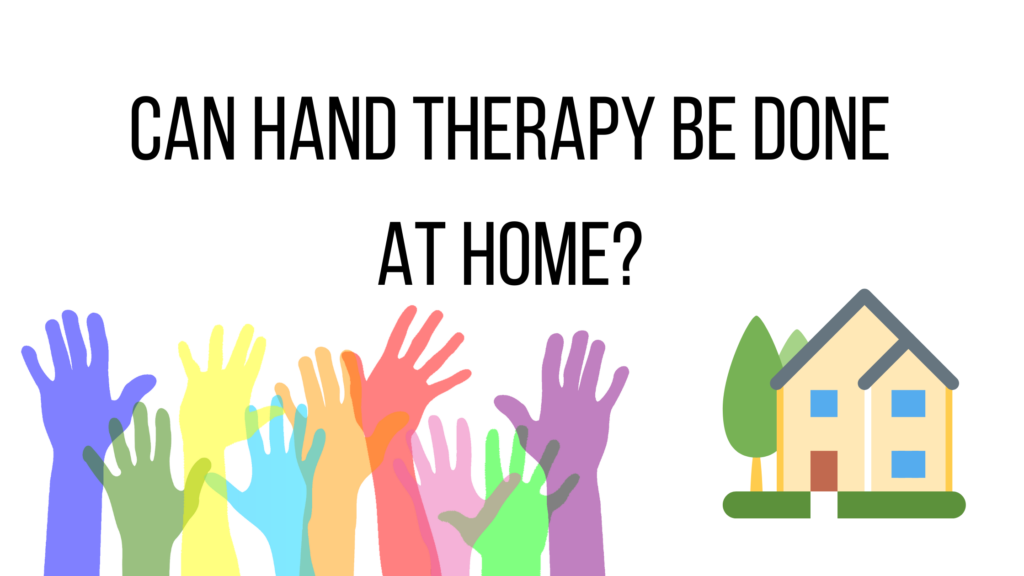If you’ve recently had a hand injury, the thought of doing hand therapy may be inconvenient, costly, or not seem worth it.
You may have wondered, can hand therapy be done at home?
Hand therapy can be done at home if there are no restrictions, impaired range of motion, minimal swelling, and the physician approves home therapy.
For a more specific answer, continue reading to know what guidelines to follow for doing your exercises at home and what information you can ask your doctor or therapist to make therapy at home a possibility.
Disclaimer: You should always consult a licensed physician before doing therapy at home.
Check with your doctor or therapist before doing therapy at home
It’s always best to check with your doctor or therapist before doing hand therapy at home, so you don’t make the injury worse.
Some hand injuries are delicate and require careful attention, while other injuries may benefit from simple exercises at home.
For example, if you lacerated a tendon or broke a bone, therapy at home could make the injury worse. This could result in decreased functional use of your upper extremity and lead to problems at home or work.
There are also times when you have a simple injury, but swelling, pain or other complications can make the problem worse.
In these circumstances, it’s helpful to have a hand therapist to push you, so you don’t lose any range of motion or grip strength.
Therapy can also be beneficial to hold you accountable to your daily exercise program. A hand therapist can tell you when you’re ready to progress to the next level of exercises and what movements to avoid.
Most of us tend to put off our stretches and exercises after 1-2 weeks, but a therapist will be measuring your progress weekly and help you see your progress. They will also be pushing you past your limits and motivating you. Having someone to motivate and hold you accountable can result in a much better recovery.
Can I do therapy at home if I can’t afford it or don’t live near a hand clinic?

Some patients are unable to pay for weekly therapy or may not live in close proximity to be able to attend their hand therapy sessions.
While these are both valid reasons, it’s still always best to check with your doctor or therapist before making that decision to do therapy on your own.
Here are a few hand related injuries that would benefit from a hand therapist:
- Significant swelling
- Scar adhesions limiting motion
- Decreased range of motion
- Tendon injuries
- Displaced fractures
- Open wounds
When is it safe to do hand therapy at home?
If you’ve already seen a doctor about your injury, here are a few guidelines that might help decide if it’s safe to do therapy at home.
- Minimal swelling
- Full range of motion
- The injury is more than 6 weeks old
- You understand your home exercise program
- You know your splint guidelines
- Stretching doesn’t cause significant pain
- Your injury doesn’t require a specialized splint
- You have no restrictions
If you’re still not sure, you can always call your doctor’s office and ask what he/she recommends for therapy.
If you’re already seeing a hand Therapist
If you’ve already seen a therapist for over a month, you know your exercises, and you feel like you can do everything in therapy at home, it’s probably okay to do your therapy at home.
Always talk to your therapist before doing therapy at home as your therapist may make changes with the plan of care over time. This might include strengthening exercises, scar immobilization, and other modalities that may be beneficial for your recovery.
When is it not safe to do hand therapy at home?
The injuries listed below would require close supervision by a hand therapist.
- Any complicated injury
- Recent displaced fracture
- Tendon repair
- Significant swelling
- Limited range of motion
- Pain with movement
- Decreased sensation
- Active bleeding
- Management of wounds
How to do hand therapy if I don’t live near a hand therapist?
Living far from a hand therapy clinic can make seeing a hand therapist much more challenging. If the injury is serious, try asking if a local hand therapist in your area is willing to do an online therapy session.
You might also ask your local hand therapist if they can send you a home exercise program. Most hand therapists have protocols for specific injuries and may be able to provide you with a copy.
You might also try visiting a hand therapist once per week to see if you’re progressing. Your therapist might be able to tell you if you’re not stretching enough, how you’re progressing, or help you know what exercises you should be doing next.
Can I do hand therapy at home if I’m on workman’s compensation?
Usually, workman’s compensation patients will be penalized if they don’t show up to their therapy appointments. Check with your claims coordinator to see if you can do your therapy at home.
If you do your therapy at home, you may be expected to return to work sooner, because you aren’t requiring a skilled service.
What you should know before doing Hand Therapy at home

1 – Home Exercises Program (HEP)
If you plan to do your exercises at home, make sure you have a home exercise program. If you don’t have a HEP, contact your local hand therapist.
Your home exercise program should also list the frequency and duration of each exercise. In other words, you need to know how often (Frequency) and how long (Duration) you should be doing the exercises.
You should also know how many weeks you should be doing these exercises until progressing to more aggressive exercises.
2 – Splinting Requirements
If your therapist or doctor wants you to wear a splint, you should check the frequency and duration. Find out if you supposed to wear the splint day and night or just a few hours each day?
If the splint is causing pain and causing redness you may need to have the splint adjusted. In this case, follow up with your therapist to have the splint modified to avoid a pressure injury.
Every splint has a different purpose depending on the injury and recommendations, so it’s always best to know when to wear your splint and how to care for it.
3 – Restrictions
If you’re concerned about doing therapy at home, ask your doctor or therapist about your restrictions.
Here are a few questions you might ask your doctor or hand therapist:
- Can I take a shower
- What movements should I avoid
- What are my lifting restrictions
- Should I sleep in my splint
- Can I take my splint off for exercise
- Can I open a sealed jar or use a can opener
- Can I type on the computer
- Can I work
- Should I take the splint off at work
Conclusion
Hand injuries can be complicated, and it may be tempting to just do therapy at home, but it’s always best to first consult with your physician or therapist.
If doing hand therapy at the clinic isn’t a possibility, talk to your local therapist about other ways you can follow up without meeting in person.

David is the lead editor of OT Focus. He has been practicing as an Occupational Therapist since 2013. He specializes in acute care, hand therapy, and ergonomics.




![How to reduce hand swelling [Hand Therapy basics]](https://otfocus.com/wp-content/uploads/2021/03/How-to-reduce-hand-swelling-1024x576.jpg)